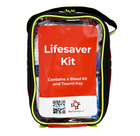Helmet Removal
Unlock This Video Now for FREE
This video is normally available to paying customers.
You may unlock this video for FREE. Enter your email address for instant access AND to receive ongoing updates and special discounts related to this topic.
Helmet Removal Procedure and Safety Tips
Risks Associated with Helmet Removal
Chin Strap Concerns: Removing helmets must involve two trained individuals to mitigate the risk of airway obstruction caused by the chin strap.
Step-by-Step Helmet Removal
1. Chin Strap Release
Technique: Lift the red tab of the chin strap to release it easily, aiding in airway clearance.
2. Visor Adjustment
Procedure: Lift the visor for better access to the patient's face and enhanced visibility during the removal process.
3. Glasses Removal
Precaution: Gently remove glasses to prevent interference during helmet removal.
4. Head Stabilization
Technique: Securely grip the helmet low down, aligning the head with the spine to maintain neutral alignment.
5. Coordinated Removal
Procedure: With one person stabilizing the head, another removes the helmet in a coordinated rocking motion, ensuring minimal movement of the head and neck.
6. Chin Piece Removal (If Applicable)
Method: If the helmet has a flip-up chin piece, carefully remove it before helmet removal, facilitating the process.
Post-Removal Considerations
Helmet Examination
Assessment: Inspect the helmet for damage, noting impact zones and potential injuries. The helmet should accompany the patient to the hospital for further evaluation by consultants.
Conclusion
Helmet removal requires careful coordination and attention to detail to prevent additional injury to the patient's head and neck. Proper technique ensures the safe removal of the helmet while maintaining head and neck stability.

_-Trauma_8x20_CE.jpg)





